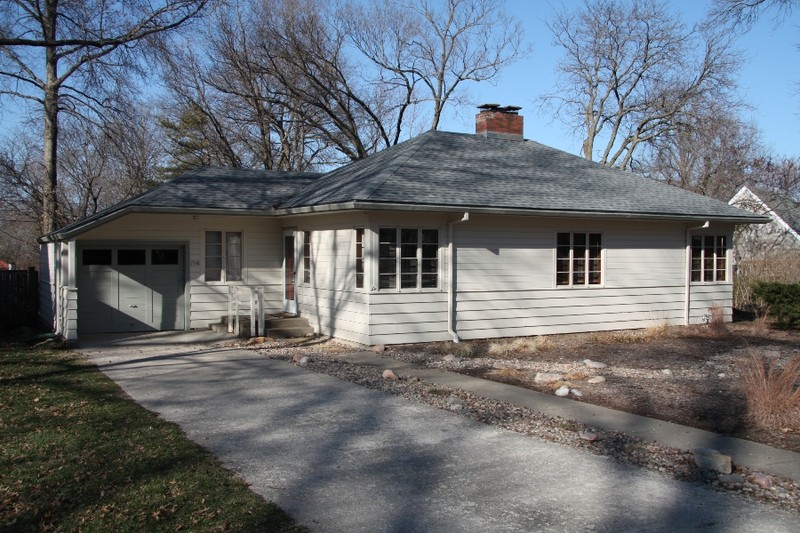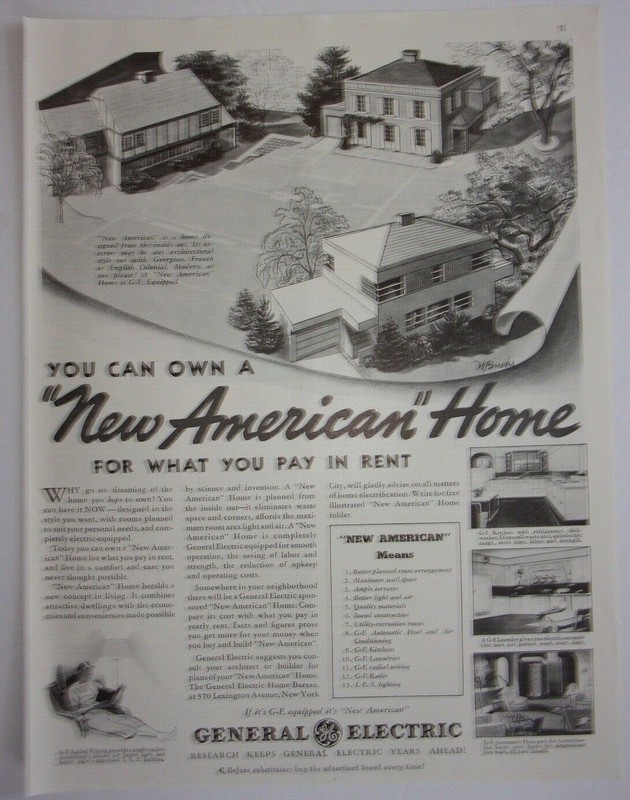Chewning House
Introduction
Text-to-speech Audio
Built in 1936 for Helen and Bert Chewing as one of 1,000 Federal Housing Authority (FHA) and General Electric (GE) "New American Home" properties during the Great Depression, the home enjoyed a new (at that time) all-electric design. Additionally, the project existed under the umbrella of President Franklin D. Roosevelt's New Deal program that put people to work by building the unique homes; builders, architects, financiers, and suppliers all benefited. Lastly, the home stood as one of the first modern homes built in Lawrence, marking the start of a rejuvenation for Lawrence that had last witnessed a boom in the years following the Civil War before the Panic of 1873.
Images
Southern facade and driveway entrance of the Chewning House

An advertisement for the New American Home Project

Backstory and Context
Text-to-speech Audio
Humanity's attempts to harness and manage electricity involve many notable figures, including the two most recognizable individuals, Ben Franklin and Thomas Edison. By 1880, Edison had solved many of the electric lamp's earliest problems by experimenting with the work done by numerous others preceding him for nearly a century; he received the historic patent that led to the modern-day light bulb on January 27, 1880. Edison understood that a light bulb would mean nothing without an effective method to distribute electricity. So, three years after creating the light bulb, he developed and installed the world's first central electricity generating plant in New York City, ushering in the modern electrical era.
Still, the availability of electricity remained elusive for most of the population for decades, reaching only eight percent of American homes by 1907. However, an expansion of the electrical grid and power transmission plants by the 1920s allowed electricity to reach nearly ninety-five percent of the homes in the nation's largest cities, although only thirty-five percent of homes nationwide had electricity by 1930.
The GE corporation, founded in 1892, developed into a near-monopoly within the electrical industry and stood as the nation's primary producer of industrial electrical equipment, including motors, turbines, and transformers used for railroads, utility companies, and commercial enterprises. Gerard Swope became company president in 1922 just as interest in electrical appliances gained momentum. He steered the company to focus on electrical consumer products, launching the first refrigerator in 1927; GE controlled nearly one-third of the national electricity market by 1930.
GE began to market electricity as a sign of human progress, and they sought strategies to forge a reputation for helping Americans "attain a better life." During the 1933 World's Fair in Chicago, 700,000 people visited the GE "House of Magic," where the company demonstrated to visitors how electricity could make life easier, especially for housewives. Similarly, GE launched its traveling display known as "Kitchen Coach," which traveled around the country to various cities and towns, such as Emporia and Iola, Kansas, in 1933. One can argue the company's strategy proved successful as a social change arose where home buyers increasingly sought "modern" homes, which usually meant having electricity and the associated electrical appliances.
The company grew despite the nation enduring the Great Depression. Although the company did experience a seventy-five percent decline in revenues during the first three years of the 1930s, GE responded by shortening the work week, cutting wages, and reassigning skilled workers to lower-skilled positions rather than laying them off; the company turned a $13 million profit in 1933. Additionally, by keeping employees, GE continuously created new appliances such as washing machines, vacuum cleaners, food mixers, and electrical air conditioning. Furthermore, GE launched the General Electric Credit Corporation in 1932, which provided credit to consumers who could not obtain it from struggling banks. Extending credit, maintaining product development, and retaining workers during the Great Depression allowed GE to maintain control of the market (and expand mightily quickly when the Depression ended).
Swope also understood the value of working with the federal government as part of FDR's New Deal programs during the Depression, such as partnering with the Tennessee Valley Authority (TVA) to expand electricity to rural areas and developing the "New American Home" project. Part of FDR's Great Depression relief efforts included the passage of the National Housing Act on June 27, 1934, which, among other things, created the FHA and the Federal Savings and Loan Insurance Corporation. The Housing Act intended to revive a housing industry that boomed during the 1920s but declined substantially during the 1930s. The FHA offered federal repayment guarantees to financial institutions that issued mortgages if they adhered to federal housing and economic standards. GE developed a strategy to work with the FHA, primarily by proposing a plan to manage a design contest where GE would select winning designs and then coordinate with the FHA the process of turning that design into a house, thus providing work to the architect along with local financiers, builders, and suppliers.
Of the 9,700 entries submitted, GE selected 500 winners (eventually 1,000 in total) and incorporated them into the program's first "New American Home," a model displayed in 1935 on the eleventh floor of the R.C.A building in New York City's Rockefeller Plaza. Visitors flocked to see model New American homes throughout the U.S., including 65,000 people viewing the New American Home on Michigan Avenue in Chicago during its nearly three months of being open to the public. The New American Homes project gained notoriety for homes with all-electrical features and an "inside-out" design, both innovative ideas in the 1930s. Whereas traditional design emphasized crafted exteriors and ornate architecture, the New American Home focused on comfort, convenience, and modern living, with electricity a significant aspect of that approach. The program furthered (much to GE's pleasure) people's desire to have an all-electrical house.
The historic Chewnings' house arose during the second year of the New American Home program. The GE-sponsored homes initially functioned as models open to the public for examination before going on the market for sale. While some locations supported several New American Homes, the Chewnings' House emerged as Lawrence's only home from the program. In just the first two days that the Chewnings' house stood as a model, more than 1,300 people visited. Like most New American Homes, the Chewnings' house incorporated the latest technology, including radial wiring, scientific lighting, GE-branded appliances (dishwashers, garbage disposal units, ironers, washers, radios, and more), electric heating, and, exceptionally unusual for the time for private homes, air conditioning,
The home also served as a precursor to the era of modern architecture in the Lawrence, which took place from roughly 1945 to 1975. Throughout the 1920s and 1930s, Lawrence experienced meager growth, with only seven plats emerging from 1925 to 1938. One of those plats, the West Hills District developed in 1931, evolved into a haven for University of Kansas employees, including professors, deans, a university bursar, and the owner of the New American Home and superintendent of the University's post office, Bert Chewning.
The placement of Chewning's modern, electric home fit the overall concept of West Hills as planners intended for it to exist as a modern approach to home building and community planning. In one aspect, restrictive social rules applied, such as requiring all plats be sold and resided by White residents and limiting housing to single-family homes (although they eventually provided exemptions for Fraternity and Sorority housing); the community existed for the White, middle class. From a building and engineering aspect, planners located West Hills houses in a manner that offered owners an appealing view rather than adhering to the traditional street grid. The West Hills District homes also included a modern trend of pre-installing utilities rather than leaving it to new homeowners to arrange and pay for utility installation.
West Hills resident and University of Kansas architecture professor George Malcolm Beal, selected as a winning architect during GE's contest, designed the now-historic New American Home for Chewning and his wife, Helen. Beal had worked as one of Frank Lloyd Wright's Taliesin Fellows in 1934, spent time in Paris, and eventually served as the chair of the KU architecture department (1945 to 1962), where he proved instrumental in morphing KU from a school of traditional architecture to one of modern architecture. However, the connection between Beal, Chewning, and the GE New American Home program remains a mystery.
World War II resulted in the pause between the Chewnings' House and the 1940s building boom, reflecting what happened nationally. World War II and an almost national commitment to conserve resources led to a rapid decline in all-electric house construction. But, when the war ended, soldiers returned looking to buy homes and start families, and the economy again began to soar, a surge in suburban subdivision development and housing construction materialized; new-home construction climbed from 114,000 in 1944 to 1.7 million in 1950. And, homeowners wanted electricity. The success of the Depression-era electric homes, such as the Chewing home in Lawrence, led to the post-World War II Gold Medallion Home Program; GE used similar marketing slogans for both home-building campaigns. Numerous homes with electricity arose in Lawrence after the war as the town's population soared from nearly 15,000 to nearly 45,000 by 1970 (Lawrence today has a population of more than 95,000).
Sources
"Chewning House." Lawrence Modern (blog). Accessed January 5, 2024. https://lawrencemodern.com/bakers-dozen/chewning-house/.
Crick, Lindsay. "Registration Form: Chewning House." National Register of Historic Places. kshs.org. 2018. https://www.kshs.org/resource/national_register/nominationsNRDB/KS_DouglasCounty_ChewningHouse_Listed030719.pdf.
"Live Better Electrically: The Gold Medallion Electric Home Campaign." Washington State Department of Archaeology & Historic Preservation. Accessed January 6, 2024. https://dahp.wa.gov/live-better-electrically-the-gold-medallion-electric-home-campaign#:~:text=The%20program%20had%20five%20basic,living%204)%20to%20show%20existing.
Saunders, Toby. "Who really invented the light bulb?." BBC Science Focus. June 1, 2023. https://www.sciencefocus.com/science/who-really-invented-the-light-bulb.
Lawrence Modern (blog): https://lawrencemodern.com/bakers-dozen/chewning-house/
https://www.ebay.com/itm/394042300953
